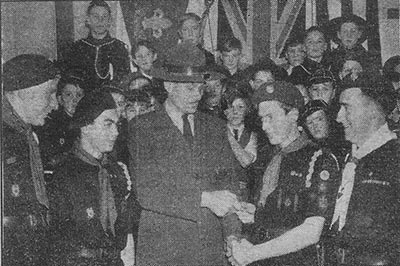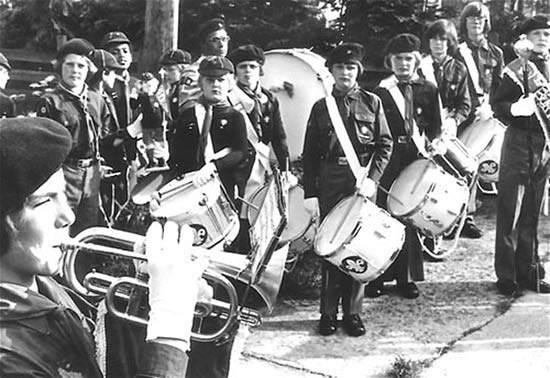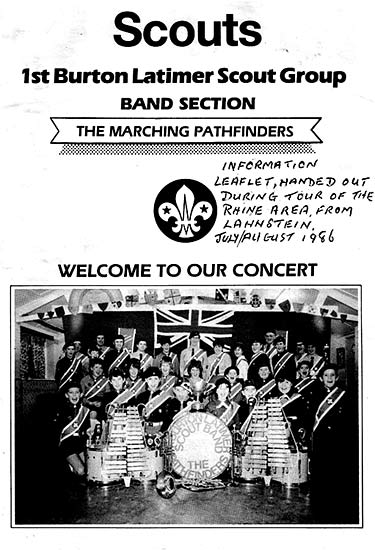|
The earliest traceable mention of the Boy Scouts in the town is in 1923 when they assisted at the Hospital Committee Fete held in the Rectory grounds. Under Master Tailby the boys together with other lads ran an “Aunt Sally” attraction. The Scouts also helped out by bringing along the log used in the sawing competition.
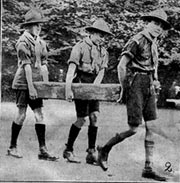 |
|
Scouts carrying log
|
A further reference appeared in a newspaper cutting of the 12 October 1928 where the Scoutmaster, H J Cook, performed the opening ceremony at the Burton Baptists’ Sale of Work.
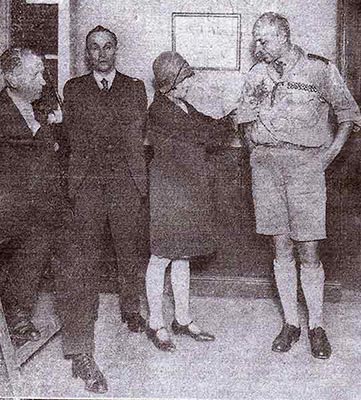 |
|
L to R: Mr H Chamberlain, Rev J Robins (pastor)
Miss Eva Carvell, Scoutmaster H J Cook
|
A quote from the Parish Magazine September/October 1930 states "Geoffrey Damms presented Rev Lethbridge with a pipe and tobacco on behalf of Burton Latimer Scouts on his retirement"
Formation of Group and the War years
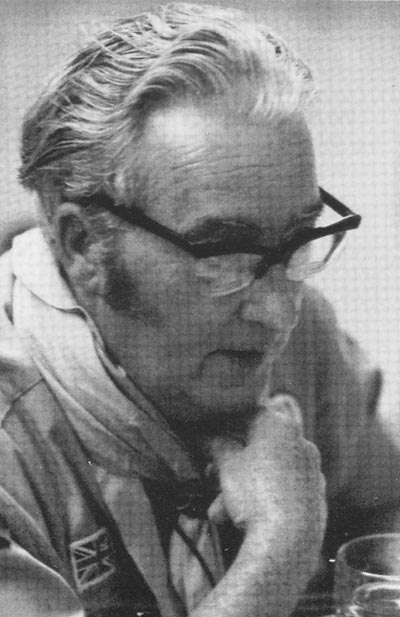 |
|
Newman John F Addis
|
|
The 1st Burton Latimer St Mary’s Boy Scout Group was formed in the summer of 1939 (a previous Scout Group was closed down over 12 years prior to this when the then Scout Master eloped with the Wolf Cub Mistress to Canada). Newman John F Addis (otherwise known as Jack) became the Leader at the request of the District Commissioner for the Wellingborough District. George Ramsbottom was appointed Assistant Scout Master together with Edna Addis (Jack’s wife) who became Wolf Cub Mistress and Molly Watson, Assistant Wolf Cub Mistress. The newly-formed group was a Church-controlled Group and the Headquarters at that time was in the Orchard Room at the Rectory provided by Rector of Burton Latimer, the Revd R W Sharpley. The official registration at this time showed that the troop consisted of 20 Scouts and 15 Wolf Cubs. The uniform was navy blue shirt, shorts and socks with a royal blue muffler. Jack Arnold was appointed Assistant Scout Master.
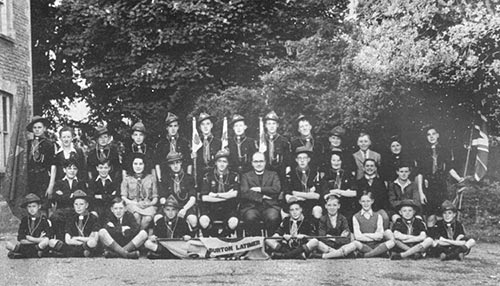 |
The original Boy Scout Group 1940
The adults in the centre of this group include Molly Watson ACM, George Ramsbottom SM, Jack Addis GSM, Rev R W Sharpley (Rector), Ray Basford PL and Edna Addis CM.
Behind them are Alan Denley, Roger Saddington, Joe Swann, ? , Edwin Ramsbottom, Norman Law and Maurice Buckby.
Some of those sitting at the front include Geoff Mason, Ivor Whiteman, Vic Brown and Don Partridge.
|
|
At the outbreak of war in 1939 the local scouts assisted in the filling and placement of sandbags at the old Mission Room which was to be an Air Raid Post. During the war they devoted many hours of loyal service to the community amongst which was a cycle messenger service, helping to man the switchboard at the old Fire Station in Duke Street, part-time fire fighters and air raid rescue squads and in collecting very useful metal and waste paper from areas adjoining Burton Latimer. The scouts also assisted in the movement of evacuees from London and it was as a result of this that the Group’s numbers increased to well over 70 scouts and 20 cubs with 55 of these from different backgrounds and religions.
As the Scout Masters were called into the services together with the Patrol Leaders as they reached call-up age, young Patrol Leaders were in charge under the supervision of Gilbert Tompkins, a leader from the 1st Finedon troop. One member of the troop, a senior scout patrol leader, Sgt Joe Swann, was lost on active service - shot down over Berlin in 1944.
As the Orchard Room at the Rectory was taken over by the Military during the war the Group’s meeting place moved to the rear of the Finedon Street Working Men’s Club in Rosebery Street with no heating, lighting or gear of any kind. Shortly after the end of the war in 1946 Jack Addis returned to the position of Scout Master. However the name of the group was changed from the Church link to the 1st Burton Latimer Boy Scout Group in order to accommodate a mix of religions.
Change of venues in the late 1940s
In 1947 the use of the meeting room at the Working Men’s Club was lost and meetings were then held in the street and in the old paddock (now the Town Bowling Green) until permission was given to use a room in the school in the High Street. As the evacuees were returning home at this time the troop was reduced to 17 Scouts and 16 Wolf Cubs. George Ramsbottom returned and together with Edwin Ramsbottom (his brother) became Scout Masters with Jack Arnold as Senior Scout Master. Mrs Addis was in charge of the Wolf Cubs.
In the late 1940s Captain Harpur of Burton Hall deeded land to the Group - close to the footpath leading from Finedon Road where it joins Higham Road - to provide a headquarters for the sum of £5.00. In addition an old army barrack hut from behind the Hall was offered which had to be dismantled, trek-carted and reassembled on the land. The 30 ft x 18 ft building was re-erected on ‘borrowed’ concrete with heat provided by an old tortoise stove on which was burnt leather bits from the various shoe factories in the town. Paraffin lamps provided the lighting for this building and an old tin hut was built later as a toilet facility.
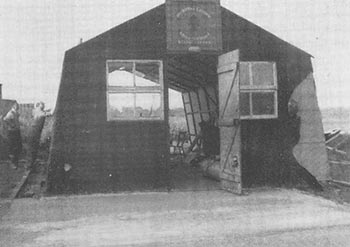 |
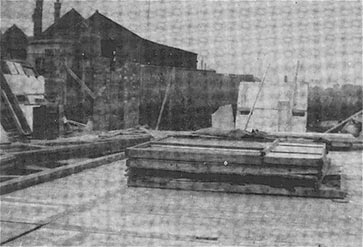 |
|
The Group's First Headquarters
|
The Second Building on the site
|
About this time three senior scouts, Peter Stapleton, Brian Johnson and Ian Kightley, attended the first post-war Jamboree near Paris.
The photograph below shows the Armistice Day Parade in 1949 approaching the Baptist Chapel for the service. Jack Addis leading the scouts at the rear with Bill Joyce, a senior sixer, aged 10, carrying the flag at the front.
 |
|
The 1949 Armistice Parade
|
In 1949 the Silverwood Cup was awarded to Kestrel Patrol under the leadership of David Coles in the Wellingborough district camping competition. The scouts involved were Brian Devine, John Coleman, Cedric Handy, Malcolm Ellingsworth, Derek Ellingsworth and Jim Arnold. This cup was retained in 1950 with the team of David Coles, John Coleman, Jim Arnold, Gordon Ayre, Don Middleton, Andy Payne and Barry Mason. In 1951 the group organised the first District Camp at Orlingbury and once again won the Silverwood Cup.
Two Early Camp Scenes c1951
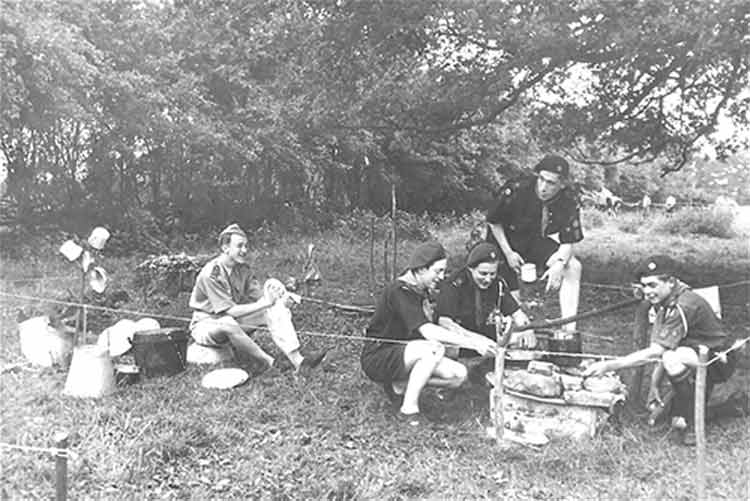 |
|
Left to Right: ?, James Arnold, Gordon Ayre, Malcolm Thurlow, Tony Middleton
|
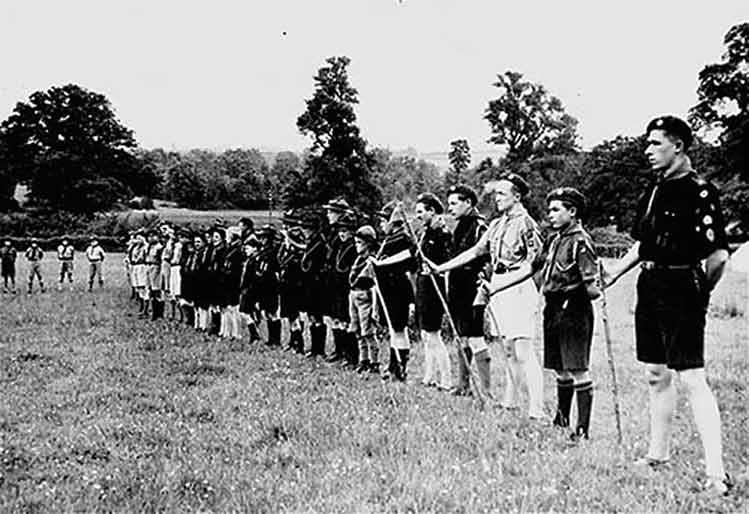 |
|
From Right: Malcolm Thurlow, Tony Middleton, ?, Gordon Ayre, James Arnold
|
7th World Jamboree in Austria
In 1951 John Arnold, Senior Scout Master, and three senior scouts James Arnold, Gordon Ayre and Malcolm Thurlow, represented the group at the 7th World Jamboree in Austria.
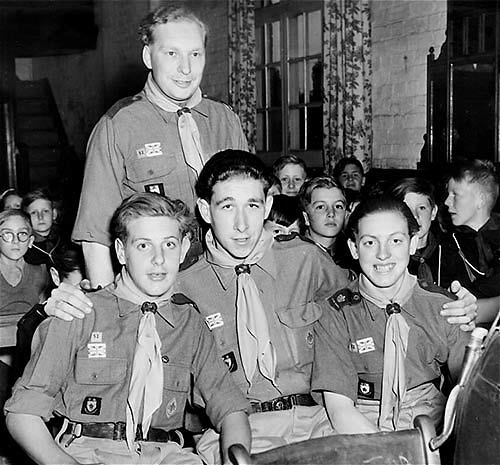 |
|
Standing: John Arnold. Front: Gordon Ayre, Malcolm Thurlow, James Arnold
|
First King's Scout Badge Awarded
1951 was also the year that the group gained its first King’s Scout Badge which was presented to Patrol Leader Malcolm Thurlow by County Commissioner Sir Wellwood Maxwell.
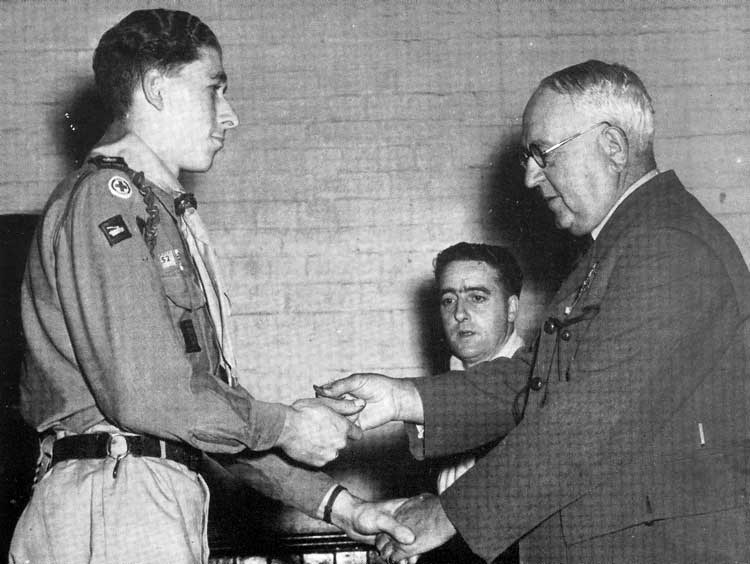 |
|
Patrol Leader Malcolm Thurlow receiving the first King's Scout Badge in the Group, presented by County Commissioner Sir Wellwood Maxwell. Scout Group Master Jack Addis is at the rear of the photograph.
|
Membership of the group was increasing and in 1952 King’s Scout, Malcolm Thurlow, was chosen to represent the county at the St George’s Day Parade at Windsor Castle.
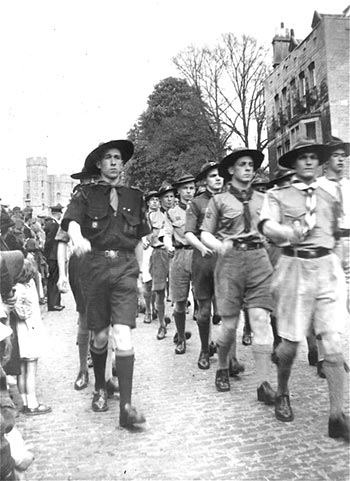 |
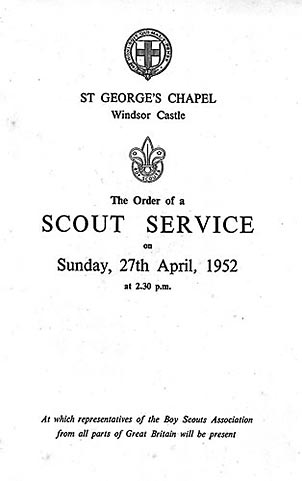 |
King's Scout Malcolm Thurlow
leading the column at Windsor
On the right: Top - Service leaflet
On the left Bottom - Ticket of Admittance
|
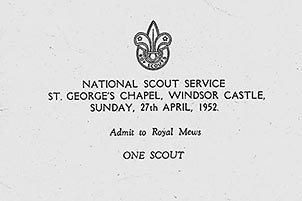 |
In 1953 the sad death of King’s Scout, Malcolm Thurlow was announced. He died suddenly after joining the Coldstream Guards
Queen's Scout Badges Awarded
Queen’s Scouts awards were gained by Senior Scout Jim Arnold and Don Middleton and in 1953 they were chosen to take part in the St George’s Day parade at Windsor Castle The Group was chosen to erect a beacon to commemorate the Coronation of Queen Elizabeth II. Anthony Drage won the cup for the largest sum earned at ‘Bob-a-Job’ week with Michael Cook earning the honour for the Wolf Cubs.
In 1954 the Silverwood Cup was held by troop leader, Barry Mason, together with scouts, Michael Ridgway, John Lack, Michael Lack, Harry Whitlock, Bill McGrath, Bill Joyce and Roger Middleton. Success in the Silverwood Cup followed in 1955 with the team of Michael Ridgway, Michael Lack, John Lack, John Addis, Roy Sharpe, Bill McGrath, Tony Clarke and Rodney Evans. Contact was made with French scouts when the summer camp was held overseas for the first time at Fontainbleau (Click here for gallery of photographs). The camp was organised by Corporal John Christian, one of the old Burton Latimer scouts who was stationed with NATO. Jack Arnold received his Long Service Award and 1955 was the year that the old type of scout hat disappeared and the green beret became the uniform headgear.
During 1956, three more Queen Scouts were created, Bill Joyce, Roger Middleton and Tony Middleton.
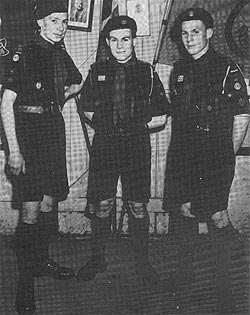 |
|
Bill Joyce, Tony Middleton, Roger Middleton
|
The annual Summer Camp took place at Wassenaar in Holland organised by Mr Andre Overduin who was a GSM of a Scout Group in the Hague.
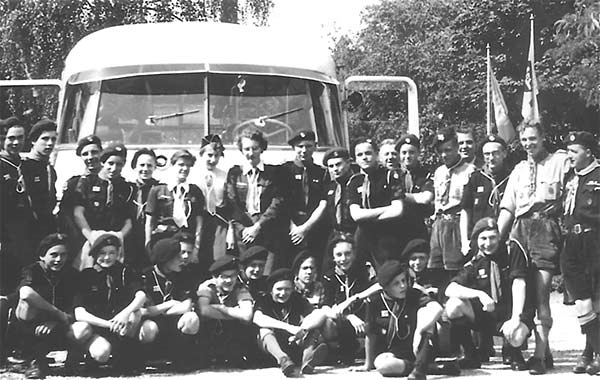 |
|
Burton Latimer Scouts in Holland 1956
|
Celebration of Fifty Years of Scouting
Fifty years of the scouting movement was celebrated in 1957 and this was the year that the Group erected the Headquarters building that now exists. The current buildings were of dismantled prefabricated construction which cost £643 16s 8d. The construction of the new building proceeded through 1958 and the official opening took place on 25 April 1959 by the Lord Lieutenant of the County who was also the County President, Earl Spencer. Michael Ridgway was presented with his Queen Scout’s Badge by Earl Spencer and a painting of Lord Baden Powell painted by Graham West (one of the old scouts) was also presented on this occasion.
A very large wheel light was gifted to the group from the George William Group of the Hague who camped in Burton in 1957. It was renovated and rewired and installed in the centre of the Headquarters.
In 1958 awards for Bob-a-Job Week went to John Byland and Michal Cook for being the top fund raisers. They were presented the awards by Janet Northern and George Ramsbottom.
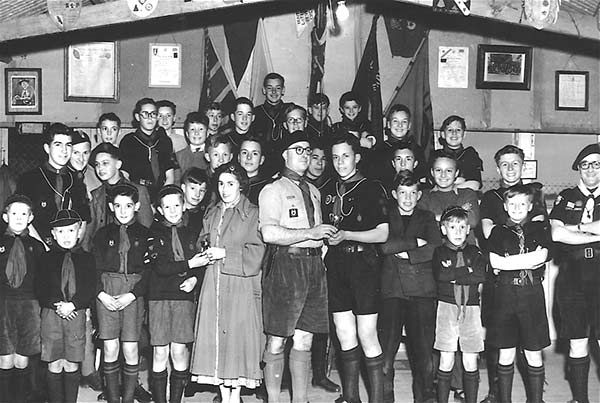 |
|
Bob-a-Job Week 1958
In the centre of this large group are John Byland? amd Michael Cook receiving awards from Janet Northern and George Ramsbottom for being top fund raisers during 'Bob-a-Job' week.
|
In 1959 the death took place of the Rover Leader and ASL, Rod Dew who had recently received his Medal of Merit for his work with the Rover Crew.
During the year the first monthly magazine of the Group was produced – the ‘Burtonian’. The Silverwood Cup team of Patrol Leader Trevor Jones, Harold Lutner, John Whitlock, Roy Smith, Johnny Johnson and Paul Blott took second place. The Gilby Cup teams were first and second. The winning team was made up of Patrol Leader Neil Osborn with Barry Lond, Kevin Devine, Brian Oram, John Byland and Craig Ainge. The runners up consisted of Patrol Leader Deryck Smith with John Whitlock, Alan Clarke, John Cooch, Edris Hull and Johnny Johnson. The new Rover Den was officially opened later in the year. The first Rover/Ranger/Senior Scout Conference was held in the Headquarters.
Highlights of the 1960s
In 1960, the Assistant Scout Master, John Hollingsworth was selected to represent the County at the International Indaba in Holland. Jack Addis was presented with the Medal of Merit by the County Commissioner, Dr S J S Hughes at a celebration for the Group’s 21st Birthday. A Patrol from the group attended the Boy Scouts of America’s Jubilee Jamboree at Fonthill Park, Tisbury, Wilts. More Queen’s Scout badges were awarded to Senior Scouts Graham Whitney and Tony Clarke A special weekend camp was held with American Scouts at the USAF Air Base at Mildenhall.
 |
|
At work on the Leaders' Den
|
|
The Leaders' Den was opened on 15 April 1961 by Major Harvey Hoyt. Queen’s scouts represented the Group at the St George’s Day Parade at Windsor Castle. Thanks badges were awarded to Mr and Mrs Charlie Cook and Mr Johnson who had worked hard on the committee for many years. Teams came first and second in the Silverwood Cup and the annual Summer Camp was held at Wolskuil, Ommen, North Holland.
In 1962 Mr Dennis White was awarded the ‘Thanks Badge’. The Senior Scout Troop and Rover Crew held their Summer Camp at Cannes on the Cote-D’Azur in the south of France and Allan Clarke and John Cooch achieved the Queen’s Scout award. This year the Annual Scout Camp took place at Windsor.
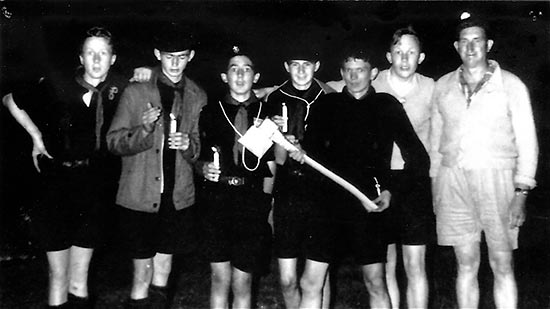 |
|
The 1962 Annual Scout Camp at Windsor
L to R: John Cooch, Tony Clarke, Bob Oram, John Hobbs, Graham Whitney, Brian Mutlow, ?
|
Peter Critchley gained the Queen’s Scout award in 1963. The Annual Summer Camp took place in Ommen, North Holland. Over 140 attended the 5th Rover, Ranger, Senior Scout Conference at the Headquarters in December.
In 1964, the Group’s Silver Jubilee year, Jack Addis was made an Honorary Commissioner of the Tucson/Arizona District of the Boy Scouts of America. New colours were presented at a special parade attended by Earl Spencer.
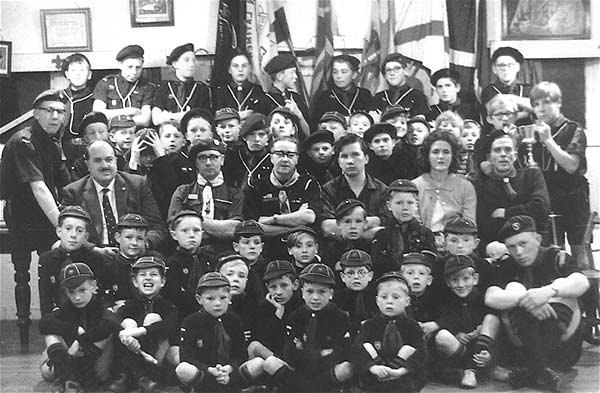 |
|
Scout Group Silver Jubilee
The adults in the centre are Dennis B White (Parents' Committee Chairman),George Ramsbottom, Jack Addis, Barry Waite, Grace Wagstaff, ? Edmunds
|
1965 saw the presentation of another Queen’s Scout award to Johnny Johnson. George Ramsbottom was awarded the Medal of Merit in July. On 28 October 1965, HRH The Duke of Gloucester, National President of the Boy Scouts Association paid an official visit to the Headquarters.
During 1966 the Wolf Cub Section of the Boy Scout Movement was renamed Cub Scouts. Two of the Queen’s Scouts, John Ramsbottom and Anthony Mellors attended the 12th World Jamboree at the Faragut State Park, Idaho, America during the Diamond Jubilee of Scouting in 1967. A Patrol Leaders' Training Course took place in this year.
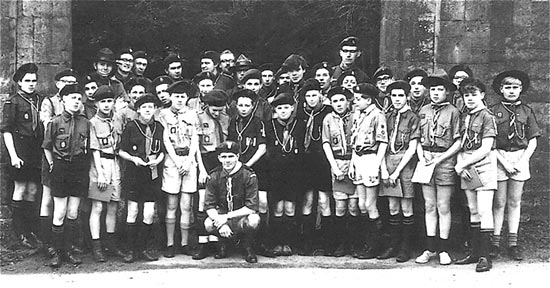 |
|
Patrol Leaders' Training Course 1966
The Burton Latimer trainee Patrol Leaders in the front in their distinctive dark blue tunics are Trevor Lovell (extreme left), R Mellors (3rd front), P Ramsbottom, John Edwards, Jimmy Keech (standing together) and M Mellors (almost hidden behind them in the crowd). Standing at the back can be seen Brian Mutlow, Harvey Waite, George Ramsbottom and John Hollingsworth.
|
Many changes took place with the Association in 1967. The word ‘boy’ was dropped, the uniform changed, Rover Scouts were disbanded, Senior Scouts were changed to Venture Scouts, Boy Scouts became simply Scouts, Wolf Cubs changed to Cub Scouts and leader’s badges of rank were abolished. A new training programme was introduced right through the Group.
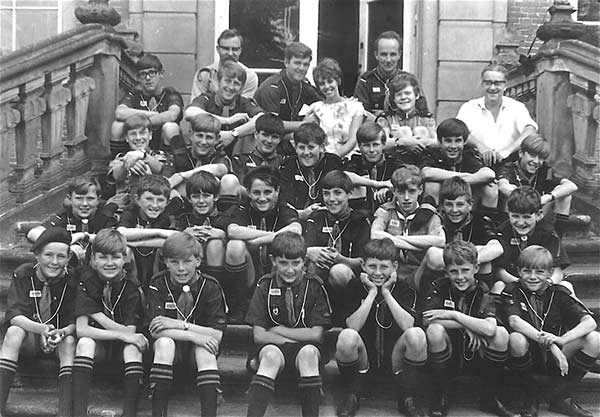 |
|
Scout Group in Holland 1967
Some surnames starting at the back: Mellors, Cooch, Jack Addis, Dixon, Lovell, Lewis, Keech, Mellors, Macmillan, Sharp, Edwards.
|
Construction of Permanent Headquarters
In 1968, work commenced on the building of a more permanent Headquarters for the Troop at a cost of £2,500. The construction was undertaken by the local firm of Underwood Builders. The majority of the interior building and decorating work was carried out by members of the Group. A Venture Scout Unit was started under the leadership of Nick Woolmer. The new Headquarters was opened on 21 September 1968 by Deryck Kemp, Assistant County Commissioner of Norfolk. The second Cub Scout Pack was formed in this year.
Jack Addis was awarded the Silver Acorn for 50 years service to the movement. C Harmon and C Bull were the first to gain the new Chief Scout’s award in the Group.
Second Scout Troop Formed
A second Scout Troop was started during October of 1976. David Roe became leader of the new Junior Troop for 11-13 year olds and Ray Chester joined David Roe as ASL. The 13-16 year olds became the Senior Troop under Trevor Jones. This two-tier system was abandoned after two years in favour of running two conventional Scout Troops. At the end of 1978, Terry Blissett, Chris Wood, Scott Bowman and Rod Bulley gained the Chief Scout’s Award and received their badges from Dr Derek Pollard, HQ Commissioner for Scouts at Gilwell Park.
Formation of Group Band
The Group’s band was formed in 1978 by Tony and Rita Ward with kazoos and drums as a fun band for the Cub Scouts.
|
|
|
The Marching Pathfinders
An early photograph of the Marching Pathfinders outside Scout HQ in July 1978, six months after being formed on 19 February
|
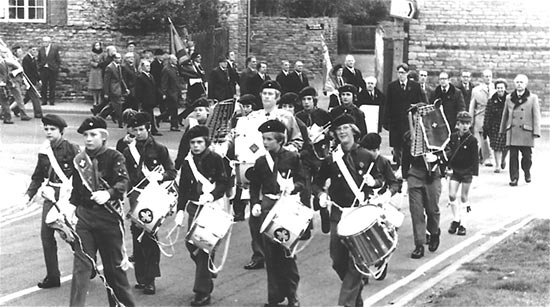 |
|
The Pathfinders First Public Parade - November 1978
Turning into Churchill Way from the High Street, leading the town's Remembrance Day Parade on its first public appearance
|
The band progressed in 1982 to playing trumpets, tenor horns and bell lyres giving concerts in various towns on the Rhine in Germany.
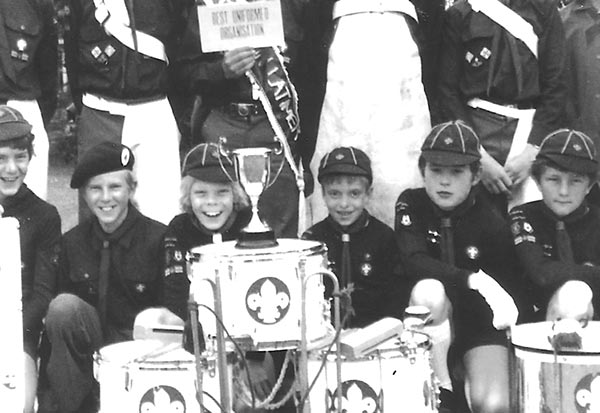 |
|
The Band took the Novice Trophy at the Scout Band contest at Leek in Staffordshire in 1983.
|
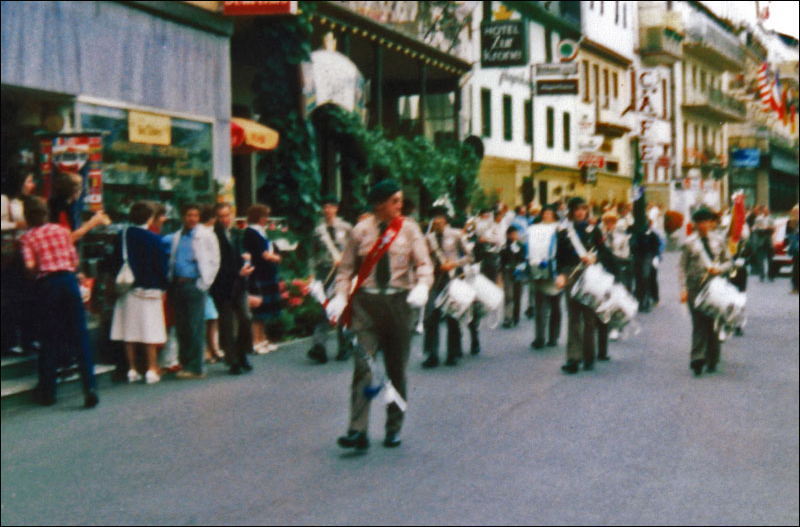 |
|
The Scout Band performing in Lahnstein, Germany, 1982
|
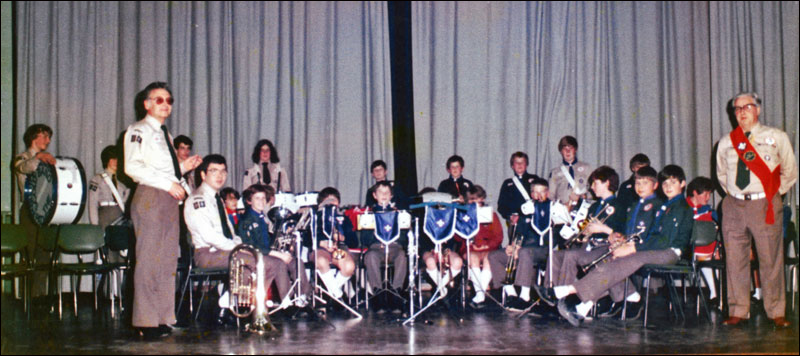 |
|
Burton Latimer Scout Band performing for the Chief Scout, 1983
|
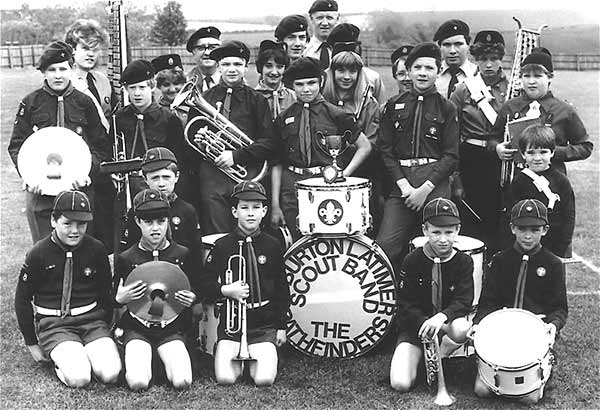 |
|
The Marching Pathfinders 1984
Standing tall at the back is Les Facer. In the back row are Lisa Wright, Jack Addis, Nicky Billington David Billington and Mick Clarke. In the next row are Claire Abrams, Karen Abrams, Amanda Roe, Sarah Skelly and Barbara Facer. The next row is Kevin Lington, Chris Banks, Andrew Hancock, Simon Loak, Andrew McGeorge and Sandra Facer. Kneeling are Paul Hughes, Stewart Rae (Thomas Skelly behind him), Richard Lington, ............?, the mascot Mathew Clarke (standing) and Ian Griffiths.
|
The Band won a third place trophy in the National Scout Band Championships in 1986 and in the summer of that year also performed in a concert in Lahnstein during a tour of the Rhine Area.
Mick Clarke who had been the Group’s Bandmaster passed away in 1987. Mick was a very talented musician and was responsible for bringing the band to its high standard. Unfortunately the band was dissolved a few years later.
Mr Dennis White
In 1978 Keith Gamble gained the Chief Scout’s award. George Perkins took over the role of Chairman of the Group on the death of Dennis White who had been Group Chairman for many years. The following year, Mrs Jean White presented the Group with new colours in memory of her late husband, Dennis.
Scouting in 1980s
In 1980, Chris Wood, Terry Blissett, Scott Bowman and Rod Bulley achieved their Queen’s Scout Badges and assisted Harvey Hoyt in America with his Redlands District Camps for three weeks. They were joined by Jack and Edna Addis. This was one of Jack’s last official functions for the Group as GSL as he retired later in the year. Tony Ward then became GSL. Paul Chennel and Paul Hamilton gained their Chief Scout awards. Girls were admitted into Venture Scout Units in this year. Tony Ward had to move away from the town and Ray Chester became the Group’s new GSL. Karen Rogers was the first female Venture Scout to gain the Venture Scout Award and Stewart Love also received the Award.
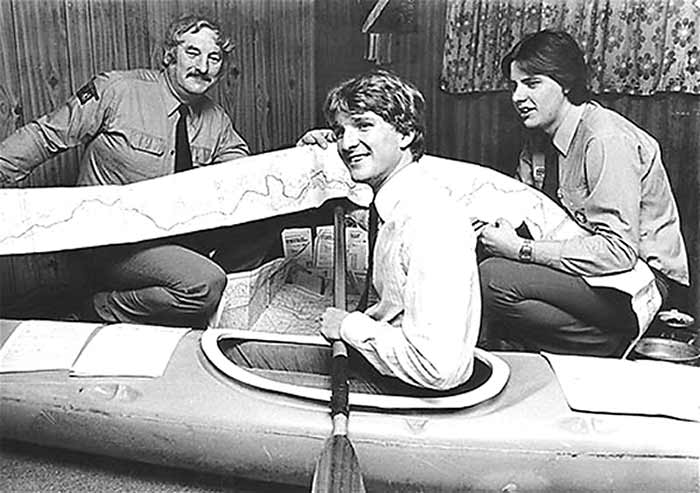 |
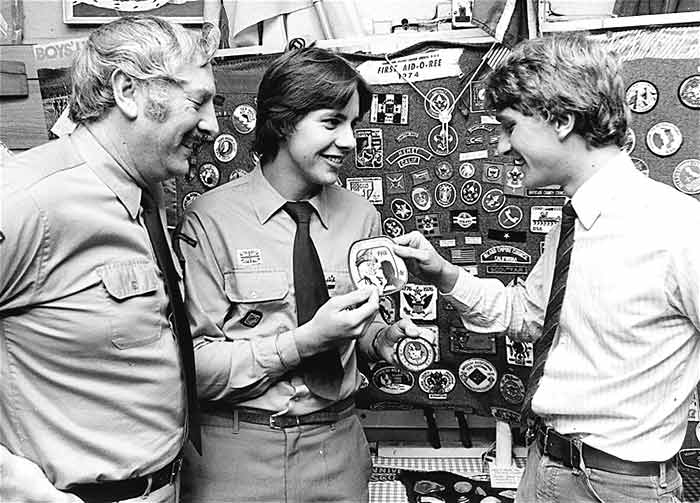 |
|
An Open Evening at Scout Headquarters c1980
Scott Bowman demonstrating activities to visitor, Adam Craddock
|
Chief Scout awards went to T Freeman, M Perkins, C Tyler, D Billington, M Elliott, C Exley and G Noble. The Troop won the Arthur Baker trophy.
In 1983, Karen Rogers, Michelle Allibone and Chris Bowers gained their Queen’s Scout awards and David Gibbs and David Barwell their Chief Scout awards.
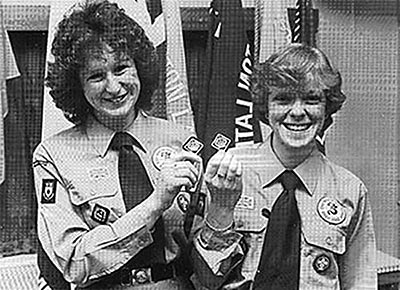 |
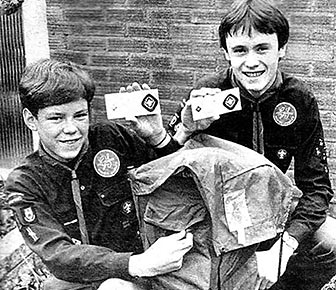 |
|
Michelle Allebone and Karen Rogers with their Queen's Scout badges
|
David Barwell and David Gibbs with their Chief Scout badges
|
Venture Scouts Paul Chennell and Harvey York attended a training camp at Helendale in the San Bernadino mountains, California whilst Caroline Wood spent her time at a massive camp in Philmont, California. All took part in the project to earn the Queen's Scout Award.
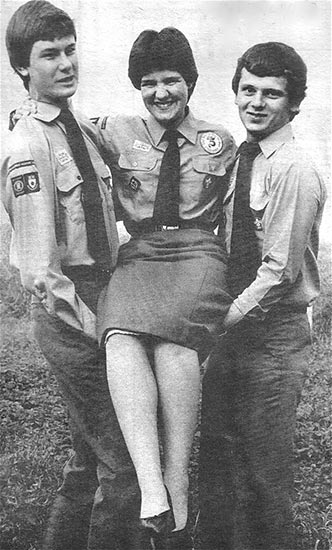 |
|
Paul Chennell, Caroline Wood and Harvey York before setting out on their venture in California
|
In July, a group of Venture Scouts took part in the 100 mile Nijmegen Walk in Holland. Two members of the group, Terry Blissett and Paul Chennell covered 128 miles (32 miles each day). Others completing the 100 miles were Sandra Lewis, Paula Timpson, Sharon Christian, Carol Smith and Steven Smith. The group was led by Brenda Dixon and Terry Blissett.
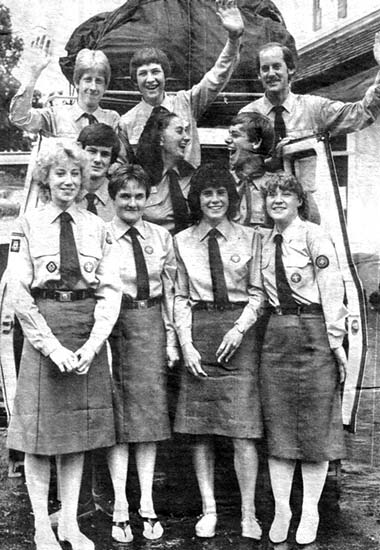 |
|
The Venture Scouts ready to commence their trip to Holland.
|
Paul Chennell and Harvey York attained their Queen’s Scout awards (see below). Chief Scout badges were gained by Sam Bosworth, Andrew Rogers, Stephen Smith, Paul Borman, Steven Jeffs, Paul Northern and Paul Hogan (see below). To receive the awards, the five had to reach high standards in scouting skills, including hiking, camping and first aid. They also had to organise social activities for younger scouts and complete a community project which involved working for the elderly. The band gave its first concert at Alton Towers at this time.
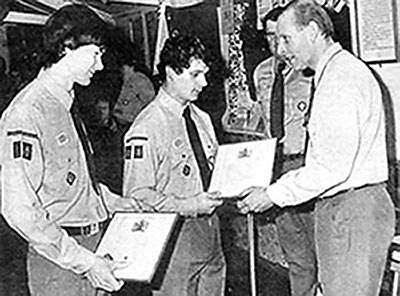 |
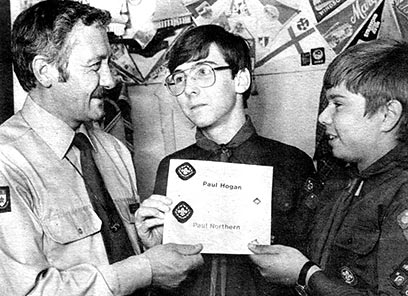 |
|
Paul Chennell and Harvey York receiving their Queen's Scout Awards from John Tilley, Assistant County Commissioner for Scouts
|
Paul Hogan and Paul Northern, both 15, receiving their Chief Scout awards from District Commissioner, Stuart King
|
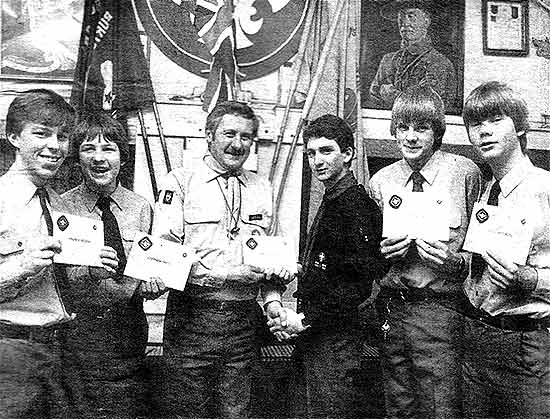 |
Winners of the Chief Scout Award
L to R: Andrew Rogers, Stephen Smith, Sam Bosworth, Steven Jeffs and Paul Barman with the District Commissioner, Stuart Kiing
|
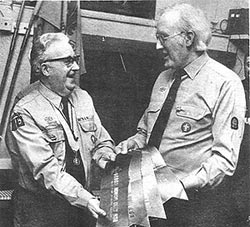 |
|
First Burton Latimer Scouts leader, Ray Chester, receiving the pennants from the Group Adviser, Jack Addis
|
|
Also in 1984, Scouts from the First Burton Latimer troop were honoured by their Ameriican counterparts for achieving high standards.
The Californian Inland Empire Council, a type of sister troop, sent special pennants to the boys for doing well in the scouting skills.
The pennants were usually awarded to American scouts as they progressed in the skills, including camping, first aid and hikiing.
In 1985 David Roe took over from Ray Chester and the Group Supporters organised the first Christmas Postal Service. Queen’s Scout badges were awarded to Sandra Lewis, Caroline Wood, Sharon Christian, Carole Smith and Andrew Macreadie.
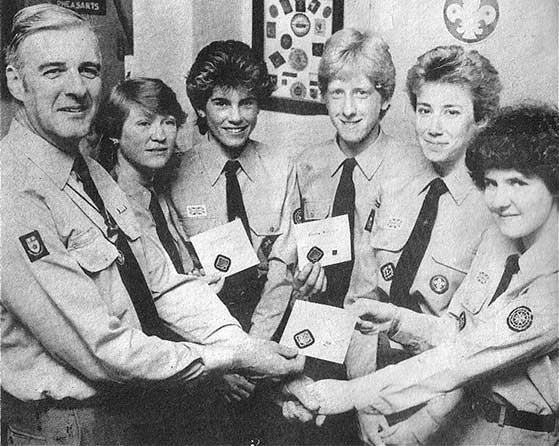 |
|
Queen's Scout Award Winners
L to R: Carole, Sandra, Andrew, Sharon and Caroline with the County Commissioner, Michael Lane
|
Paula Timpson gained her Venture Award. George Ramsbottom received the Silver Acorn Medallion (the highest awarad a scout leader can receive)for 47 years service with the Group, 45 of them as a Scout leader (see below). David Clarke, N Beasley and Simon Coles gained their Chief Scout’s awards.
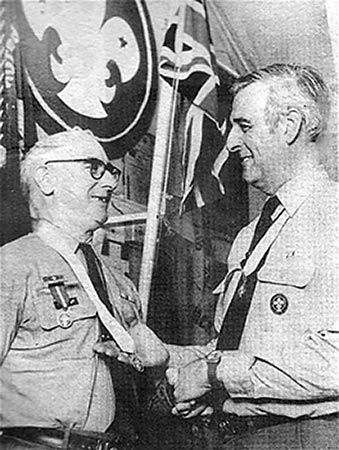 |
|
Veteran Scout, George Ramsbottom receiving the Silver Acorn Medallion from County Commissioner, Michael Lane
|
The Beavers colony was started by Maggie Blissett in 1986.
The membership in the Group in 1986 including Leaders was 160 which meant that the size of the Group had trebled in size since its formation 50 years previous.
1988 saw the celebration of 21 years of Venture Scouting and a special birthday badge was worn on the uniform. A sponsored ‘climb of Mount Everest’ took place ie the climbing of a 30’ scaffold tower the equivalent number of times to equal the climbing of the mountain. The money raised was sent to Sir Edmund Hilary to help with the work among the Sherpas in Nepal.
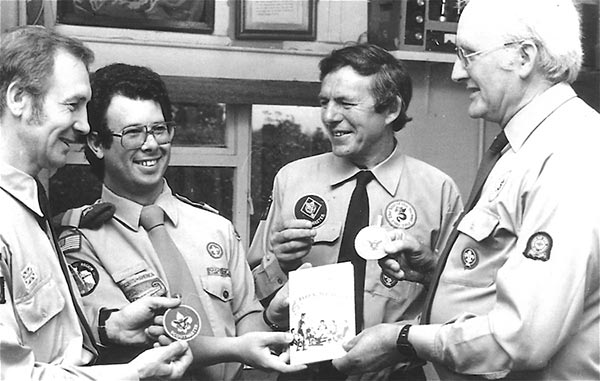 |
|
Exchange of Badges - 1980s
An exchange of badges taking place during a visit by an American Scout Leader.
L to R: Eddie Chennell, USA leader, John Northern and Ray Chester
|
50th Birthday Year
The year 1989 was the 50th birthday year for the group and a booklet was produced to commemorate the achievement.
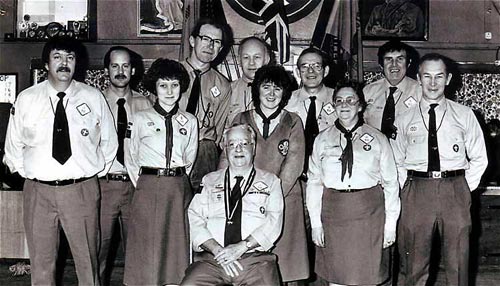 |
|
Group Leaders 1989
L to R: John Ayres, Rod Bulley, Mrs Rod Bulley. John Hollingsworth, Brian Mutlow, Linda Edwards, John Northern, Moira Perkiins, David Roe, Eddie Chennell, Jack Addis seated centre
|
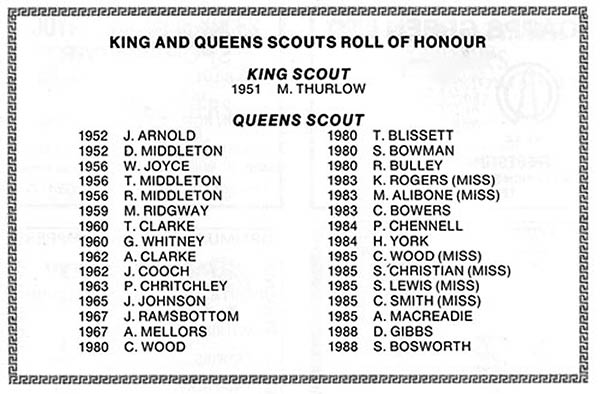 |
|
King and Queen's Scout Roll of Honour from 1951 to 1988
|
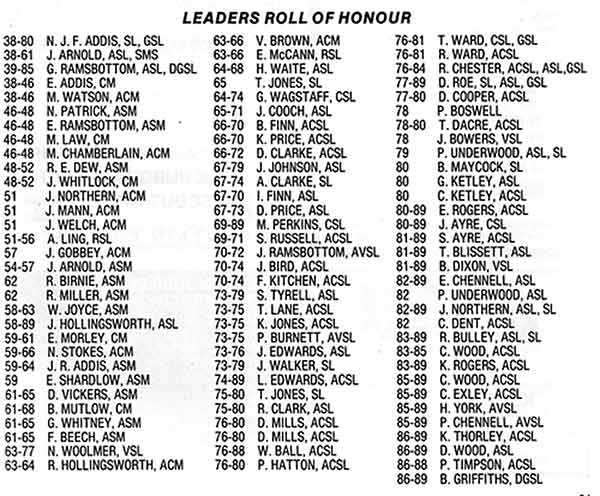 |
|
Leaders' Roll of Honour from 1938 to 1989
|
At this time Weetabix presented the Group with a cheque for £10,000 which was used to purchase a minibus. Brian Griffiths took over the role of Group Scout Leader from David Roe and was instrumental in the building of a new rear extension to the Group Headquarters. In the late nineties, Brian Griffiths' role was taken over by Bob Peden. Also at this time a new garage was erected aided by the National Lottery.
In 1991 Moira Perkins and Caroline Wood attended the District Cub Camp at Glendon and met the Chief Scout, Garth Morrison, and in May 1994 Brian Mutlow, Northamptonshire County Commissioner, also met the Chief Scout when he visited Wellingborough.
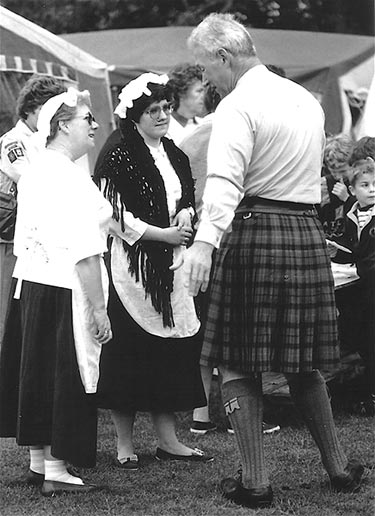 |
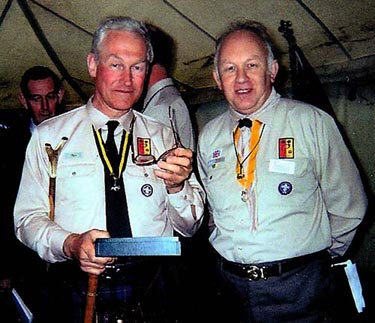 |
|
The Chief Scout, Garth Morrison, talking to Moira Perkins and Caroline Wood at a District Cub Camp at Glendon in 1991
|
The Chief Scout, Garth Morrison, with Brian Mutlow, (at the time Northamptonshire County Commissioner). on a visit to Wellingborough in May 1994
|
The 1st Burton Latimer Venture Unit was reformed in 1997.
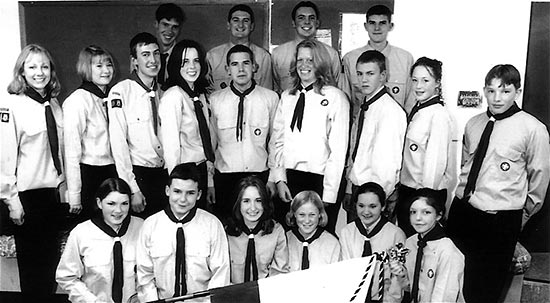 |
|
1st Burton Latimer Venture Unit - 1997
Back row: Mark Cooper, Sam Bosworth, Ian Griffiths, Matthew Young.
Middle row: Chloe Cullington, Madeline Parker, Jonathan Roe, Joanna Vinall, Adam Young, ?, Robert Hilson, ?, Bradley Joyce
Front: Hayley Joyce, Sam Cullington, ?, Fiona Guthrie, Rebecca Marchant, Teresa Callaghan
|
1999 saw the 60 year anniversary of the Group and the membership at that time numbered 190.
Mohawk Scout Troop - German International Camp - 2000
The lst Burton Latimer Mohawk Scout Troop joined 15,000 other scouts at an international camp in Germany in 2000.
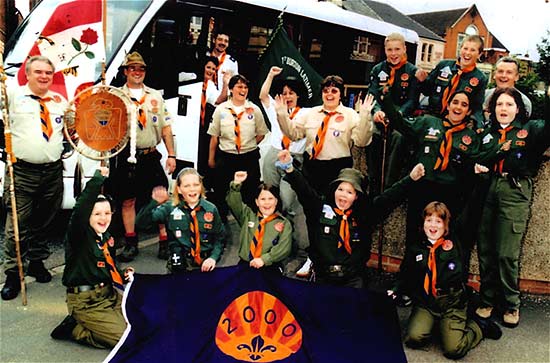 |
|
The Mohawk Troop pictured just before leaving for Germany. Assistant Scout Leader Adrian Watts is wearing the traditional scout hat and Group Scout Leader Bob Peden is extreme right at the back.
|
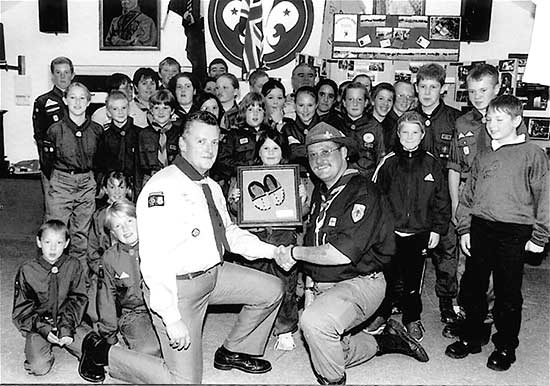 |
|
The Mohawk Troop showing off a pair of Indian Moccasins given to them as a sign of friendship by German Scouts at the international camp. Left is ASL Adrian Watts and right is GSL Bob Peden
|
To read more information about Jack Addis click here.
The Burton Latimer Scout website is at Burton Latimer Scouts
|














